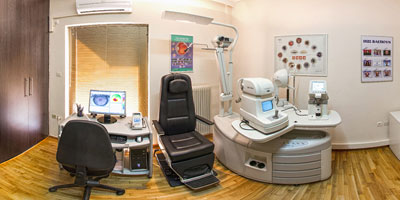Cataract
Treatment of cataracts through a tiny incision with drops
Cataracts are one of the most common causes of blurred vision after a certain age. Cataracts are part and parcel of the eye’s aging process. After a certain age everyone experiences a clouding of the lens. Surgery to remove a cataract is the most common but also the most successful surgery in the entire field of Medical Science.
 What is a cataract?
What is a cataract?
- A cataract is the clouding of the natural lens of the eye. The natural lens of the eye lies behind the iris, is the size of a lentil and is normally clear.
- It cannot be prevented nor treated with drugs.
- It is a very common ailment which occurs in advancing age.
- In some instances it may be caused as a result of injury, certain conditions (e.g. diabetes, inflammation of the eye etc) or medication such as chronic cortisone use.
- In rare cases, a child can be born with cataracts (congenital cataracts).
What are the symptoms of a cataract?
The main symptoms are:
- Clouding with progressive reduction of vision for near or far. Vision becomes less and less clear.
- Flashes and reflections around certain objects.
- Impaired colour perception.
- Intense discomfort in the sun.
- There is no pain.
All of the above symptoms can affect daily activities such as:
- Driving, especially at night or in very bright light.
- Reading or watching television. In some cases, in the initial stages of some types of cataract, reading may be possible without glasses.
- Sewing or other activities which require detailed observation of objects.
When should a cataract be treated?
Treatment can be decided upon when the cataract begins to affect the quality of vision to such an extent that it makes it difficult for you to carry out your normal daily activities (safe driving, reading, watching television). Based on your symptoms, you and your ophthalmologist will decide together when the operation will take place.
It is no longer true that a cataract must be ‘mature’ in order for it to be removed. With the new techniques (phacoemulsification, laser) this notion is now a thing of the past. On the contrary, an overripe, hard cataract makes the removal operation more difficult.
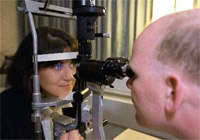 The pre-operative examination of the eye
The pre-operative examination of the eye
The eyes are examined before the operation to determine the overall condition of the eyes, the type of cataract and also to take the measurements necessary for deciding on the correct lens to be put in the eye. The detailed ocular examination includes measurements of vision and the curvature of the cornea, measurement of the eye pressure and checking the health of the back of the eye. In addition, with the help of ultrasound, the length of the eyeball is measured and the the strength of the lens to be inserted is calculated.
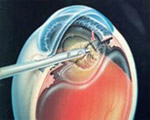 What happens in the operation?
What happens in the operation?
Nowadays the cataract is removed using phacoemulsification with ultrasound. Through a tiny incision of 2-3mm and with the help of a fine probe that emits ultrasound waves the cataract lens is emulsified and, at the same time, the fragments are suctioned out. Finally, a permanent artificial intraocular lens is implanted. The operation is carried out under local anaesthetic (eyedrops) and does not require any stitches. Vision is restored immediately.
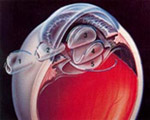 A stay in hospital is no longer necessary. The patient returns home immediately after the operation, indeed return to normal daily activities is possible from the very next day. The patient already starts to see better after the operation and vision improves day by day. The operation is carried out under local anaesthetic using eyedrops and the patient leaves the operating theatre without protective gauzes.
A stay in hospital is no longer necessary. The patient returns home immediately after the operation, indeed return to normal daily activities is possible from the very next day. The patient already starts to see better after the operation and vision improves day by day. The operation is carried out under local anaesthetic using eyedrops and the patient leaves the operating theatre without protective gauzes.
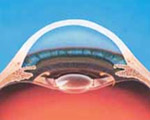 The lens that is implanted in the eye has the ability to correct myopia (shortsight) or hypermetropia (longsight) if these were present before the surgery. As a result, it is often not necessary to wear glasses after the surgery. A small percentage of patients may need glasses to make slight corrections for certain activities (driving, watching television). How to deal with postoperative corrections is discussed with the surgeon in order to meet the requirements and needs of the patient.
The lens that is implanted in the eye has the ability to correct myopia (shortsight) or hypermetropia (longsight) if these were present before the surgery. As a result, it is often not necessary to wear glasses after the surgery. A small percentage of patients may need glasses to make slight corrections for certain activities (driving, watching television). How to deal with postoperative corrections is discussed with the surgeon in order to meet the requirements and needs of the patient.
The latest technologies for cataract removal (FEMTOLASER CATARACT)
Our Centres apply all of the latest techniques for surgical removal of cataracts. A new technique is the combination of laser with ultrasound. The laser which is used is a FEMTOSECOND LASER for making the incision, creating the capsule (round opening of the lens capsule) and the fragmentation of the core. The insertion of premium intraocular lenses requires especially accurate, rounded and focused capsule delivery for better and long-term results.
Newer intraocular lenses
In our Centres, we use all the intraocular lenses of the latest technology depending on the particular case. Multifocal intraocular lenses for the correction of both distant and near vision after cataract surgery. Adaptive intraocular lenses, which mimic the adaptation of the natural lens of the eye and so the patient can see at all distances after surgery. Toric Intraocular lenses that correct major astigmatism.
On the day of the surgery
It is always recommended that the patient be accompanied by a relative who will take them to and from the clinic. The time spent in the clinic is 2-3 hours due to the pre-operative preparations. The evening before, the patient should only have a light meal, while on the morning of the surgery it would be better not to eat anything at all. The patient must take their regular medicines (for blood pressure, heart, diabetes) as usual, but not Aspirin.
After the operation
The patient waits in recovery for a little while and leaves when they themselves feel well. The ophthalmic surgeon will prescribe the appropriate eyedrops to be used at home after the operation and will give the necessary instructions. After the operation, it is important that the patient should not rub their eye and not allow water to enter the eye for one week.
What are the advantages of this method?
The technique of removing the cataract through a microscopic incision with eyedrops offers many advantages. Using this technique, the patient can return to their daily activities right from the very next day. The time spent in the operating theatre is reduced and hospitalisation is not necessary. Neither general anaesthesia nor needle anaesthesia is needed for the operation. No sutures are placed during the operation. Sutures can prove uncomfortable postoperatively and can cause astigmatism. The incision heals faster and more naturally. All of the above mean fewer intraoperative and postoperative complications, resulting in a faster recovery of vision.
 Posterior capsule opacification or secondary cataract
Posterior capsule opacification or secondary cataract
Opacification of the membrane (capsule) which is left intact during surgery to support the lens implant after the cataract is removed is known as a secondary cataract. Vision may be gradually and significantly impaired by it. In this case, the beam of a special laser (YAG LASER) is used which painlessly breaks the cloudy membrane and restores the loss of vision that occurred after the cataract surgery. This happens in about 20% of patients who have undergone cataract surgery. This operation can be performed in the doctor’s surgery as an outpatient procedure..
Prevention - Advice
 There is not really any advice regarding the prevention of cataracts. When indicated, the operation should be done in a timely manner in order to avoid possible difficulties brought on by surgery on a mature cataract.
There is not really any advice regarding the prevention of cataracts. When indicated, the operation should be done in a timely manner in order to avoid possible difficulties brought on by surgery on a mature cataract.
However, because the sun’s rays may be linked to the pathogenesis of cataracts, it is a good idea to protect our eyes from the sun, from an early age, with suitable sunglasses, i.e. those that absorb the harmful ultraviolet and high energy rays of the sun.
Finally, we must remember that the operation to remove a cataract is the most common but also the most successful surgical operation in the entire field of Medical Science.

